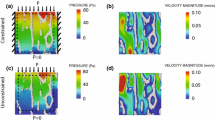Abstract
The apparent stiffness tensor is an important mechanical parameter for characterizing trabecular bone. Previous studies have modeled this parameter as a function of mechanical properties of the tissue, bone density, and a second-order fabric tensor, which encodes both anisotropy and orientation of trabecular bone. Although these models yield strong correlations between observed and predicted stiffness tensors, there is still space for reducing accuracy errors. In this paper, we propose a model that uses fourth-order instead of second-order fabric tensors. First, the totally symmetric part of the stiffness tensor is assumed proportional to the fourth-order fabric tensor in the logarithmic scale. Second, the asymmetric part of the stiffness tensor is derived from relationships among components of the harmonic tensor decomposition of the stiffness tensor. The mean intercept length (MIL), generalized MIL (GMIL), and fourth-order global structure tensor were computed from images acquired through microcomputed tomography of 264 specimens of the femur. The predicted tensors were compared to the stiffness tensors computed by using the micro-finite element method (\(\upmu \)FE), which was considered as the gold standard, yielding strong correlations (\(R^2\) above 0.962). The GMIL tensor yielded the best results among the tested fabric tensors. The Frobenius error, geodesic error, and the error of the norm were reduced by applying the proposed model by 3.75, 0.07, and 3.16 %, respectively, compared to the model by Zysset and Curnier (Mech Mater 21(4):243–250, 1995) with the second-order MIL tensor. From the results, fourth-order fabric tensors are a good alternative to the more expensive \(\upmu \)FE stiffness predictions.






Similar content being viewed by others
References
Advani SG, Tucker CL (1987) The use of tensors to describe and predict fiber orientation in short fiber composites. J Rheol 31(8):751–784
Auffray N, Kolev B, Petitot M (2014) On anisotropic polynomial relations for the elasticity tensor. J Elast 115(1):77–103
Backus G (1970) A geometrical picture of anisotropic elastic tensors. Rev Geophys 8(3):633–671
Boehler JP (ed) (1987) Applications of tensor functions in solid mechanics. Springer, Vienna
Campanella A, Tonon ML (1994) A note on the Cauchy relations. Meccanica 29(1):105–108
Cowin S (1985) The relationship between the elasticity tensor and the fabric tensor. Mech Mater 4(2):137–147
Gibson L (1985) The mechanical behaviour of cancellous bone. J Biomech 18(5):317–328
Gross T, Pahr DH, Zysset PK (2013) Morphology–elasticity relationships using decreasing fabric information of human trabecular bone from three major anatomical locations. Biomech Model Mechanobiol 12(4):793–800
Hazrati Marangalou J, Ito K, Cataldi M, Taddei F, van Rietbergen B (2013) A novel approach to estimate trabecular bone anisotropy using a database approach. J Biomech 46(14):2356–2362
Horn BKP (1984) Proc IEEE. Extended Gaussian images 72(12):1671–1686
Huynh DQ (2009) Metrics for 3D rotations: comparison and analysis. J Math Imaging Vis 35(2):155–164
Kanatani KI (1984) Distribution of directional data and fabric tensors. Int J Eng Sci 22(2):149–164
Kim G, Cole JH, Boskey AL, Baker SP, van der Meulen MC (2014) Reduced tissue-level stiffness and mineralization in osteoporotic cancellous bone. Calcif Tissue Int 95(2):125–131
Larsson D, Luisier B, Kersh ME, Dall’Ara E, Zysset PK, Pandy MG, Pahr DH (2014) Assessment of transverse isotropy in clinical-level CT images of trabecular bone using the gradient structure tensor. Ann Biomed Eng 42(5):950–959
Lekadir K, Hazrati-Marangalou J, Hoogendoorn C, Taylor Z, van Rietbergen B, Frangi AF (2015) Statistical estimation of femur micro-architecture using optimal shape and density predictors. J Biomech 48(4):598–603
Mehrabadi MM, Cowin SC (1990) Eigentensors of linear anisotropic elastic materials. Q J Mech Appl Math 43(1):15–41
Moakher M (2002) Means and averaging in the group of rotations. SIAM J Matrix Anal Appl 24(1):1–16
Moakher M (2005) A differential geometric approach to the geometric mean of symmetric positive-definite matrices. SIAM J Matrix Anal Appl 26(3):735–747
Moakher M (2008) Fourth-order cartesian tensors: old and new facts, notions and applications. Q J Mech Appl Math 61(2):181–203
Moakher M, Norris AN (2006) The closest elastic tensor of arbitrary symmetry to an elasticity tensor of lower symmetry. J Elast 85(3):215–263
Moreno R, Smedby Ö (2014) Volume-based fabric tensors through Lattice-Boltzmann simulations. In: Proceedings of the international conference on pattern recognit (ICPR), pp 3179–3184
Moreno R, Borga M, Smedby Ö (2012) Generalizing the mean intercept length tensor for gray-level images. Med Phys 39(7):4599–4612
Moreno R, Borga M, Smedby Ö (2014) Techniques for computing fabric tensors: a review. In: Westin CF, Vilanova A, Burgeth B (eds) Visualization and processing of tensors and higher order descriptors for multi-valued data. Springer, Berlin, pp 271–292
Moreno R, Borga M, Klintström E, Brismar T, Smedby Ö (2015) Anisotropy estimation of trabecular bone in gray-scale: Comparison between cone beam and micro computed tomography data. In: Tavares JM, Natal Jorge R (eds) Developments in medical image processing and computational vision. Springer, Berlin, pp 207–220
Pahr DH, Zysset PK (2008) Influence of boundary conditions on computed apparent elastic properties of cancellous bone. Biomech Model Mechanobiol 7(6):463–476
Tabor Z, Rokita E (2007) Quantifying anisotropy of trabecular bone from gray-level images. Bone 40(4):966–972
Tjhia CK, Odvina CV, Rao DS, Stover SM, Wang X, Fyhrie DP (2011) Mechanical property and tissue mineral density differences among severely suppressed bone turnover (SSBT) patients, osteoporotic patients, and normal subjects. Bone 49(6):1279–1289
Whitehouse WJ (1974) The quantitative morphology of anisotropic trabecular bone. J Microsc 101(2):153–168
Yang G, Kabel J, Van Rietbergen B, Odgaard A, Huiskes R, Cown SC (1999) The anisotropic Hooke’s law for cancellous bone and wood. J Elast 53(2):125–146
Zysset PK (2003) A review of morphology–elasticity relationships in human trabecular bone: theories and experiments. J Biomech 36(10):1469–1485
Zysset P, Curnier A (1995) An alternative model for anisotropic elasticity based on fabric tensors. Mech Mater 21(4):243–250
Acknowledgments
This research has been supported by the Swedish Research Council (VR), Grant Nos. 2012-3512 and 2014-6153, and the Swedish Heart-Lung Foundation (HLF), Grant No. 2011-0376.
Author information
Authors and Affiliations
Corresponding author
Rights and permissions
About this article
Cite this article
Moreno, R., Smedby, Ö. & Pahr, D.H. Prediction of apparent trabecular bone stiffness through fourth-order fabric tensors. Biomech Model Mechanobiol 15, 831–844 (2016). https://doi.org/10.1007/s10237-015-0726-5
Received:
Accepted:
Published:
Issue Date:
DOI: https://doi.org/10.1007/s10237-015-0726-5




